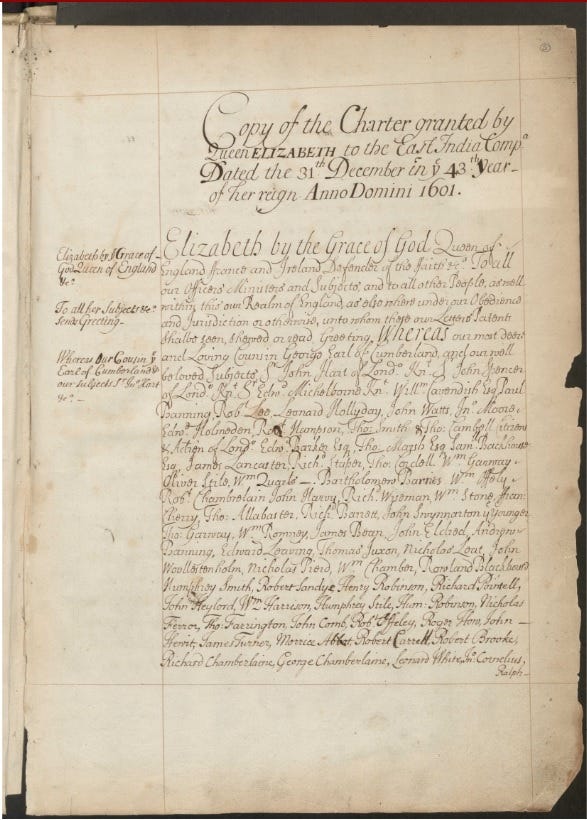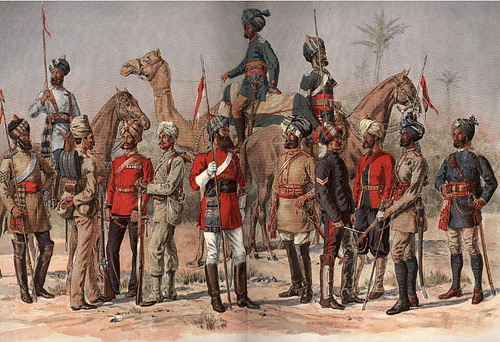The East India Company was no ordinary trading firm. Born on the last day of 1600 with a royal charter and dreams of spice, this London-based upstart would morph into a monster – a corporation with its own army, its own laws, and a stranglehold over entire nations. It built an empire of profit on the backs of millions, conquering and looting with impunity under the banner of the British flag. In its three-century reign, the Company grew from a ragtag group of merchants into what one historian calls “history’s most voracious corporation”. This is the brutal story of the East India Company’s rise and eventual ruin – a saga of monopoly, muskets, greed, and the downfall of history’s most ruthless company.
From Spice Traders to Corporate Overlords
It all started innocently enough – or so the story goes. In 1600, a group of ambitious London merchants led by Sir Thomas Smythe begged Queen Elizabeth I for a charter to chase fortunes in the East Indies. The Queen obliged. With £70,000 in pooled capital (a fortune at the time) and a monopoly license in hand, the “Honourable Company of Merchants of London Trading to the East Indies” was born. Few could have predicted that this venture would, two centuries later, rule over a subcontinent and dictate terms to emperors.
At first, the East India Company (EIC) was just another spice trader trying to elbow its way in among European rivals. The Spanish and Portuguese had dominated the spice trade until England’s navy shattered Spain’s grip in 1588. Now Britain wanted its cut. By 1602 the British Company’s ships were skirting Africa to reach the rich ports of India and Southeast Asia, setting up “factories” (trading posts) staffed by company factors to buy and ship precious goods back home. The early booty included pepper, cinnamon, calico textiles, silks, indigo dye, saltpeter (for gunpowder), and later the drug that would fuel an empire – tea. They even dabbled in the slave trade, transporting enslaved people to their colonies – whatever turned a profit.
But this outfit of penny-counting traders had a secret weapon from day one: its royal charter didn’t just grant trading rights; it gave the Company license to wage war. Imagine Walmart or Amazon with a clause in their bylaws allowing them to invade countries – that was the East India Company’s charter in a nutshell. Backed by the Crown, the Company could arm ships, fortify ports, and shoot its way to monopolies. And shoot it did. By the mid-1700s, the EIC had built up private armies to protect its warehouses and smack down competitors. What began as polite trade in the marketplace was about to become naked conquest on the battlefield.
Monopoly, Muskets, and Manipulation
The transformation from merchants to mercenaries reached its climax in 1757 on the dusty plains of Bengal. There, a Company man – a pale, unstable sociopath named Robert Clive – led 3,000 Company troops against the tens of thousands strong army of the Nawab of Bengal. The Battle of Plassey was not a fair fight; it was a masterclass in corporate backstabbing. Clive had already bribed and bamboozled the Nawab’s generals to stand down. When the gunpowder settled, the teenage Nawab was fleeing for his life, and Clive was dictating terms over Bengal. The Company, by deceit and daring, had just seized an entire Mughal province – one of the richest in India.
Keep reading with a 7-day free trial
Subscribe to Marketing Mayhem to keep reading this post and get 7 days of free access to the full post archives.






